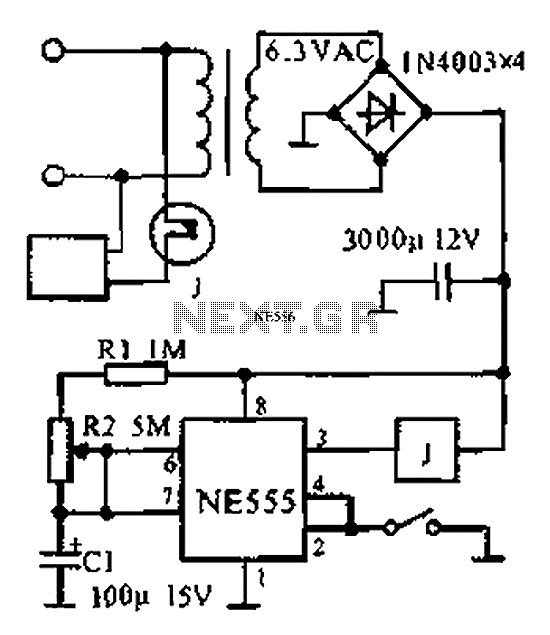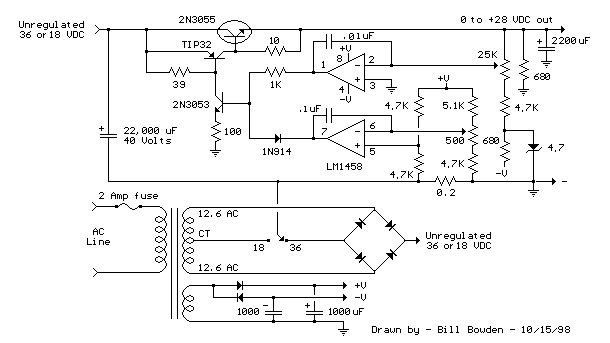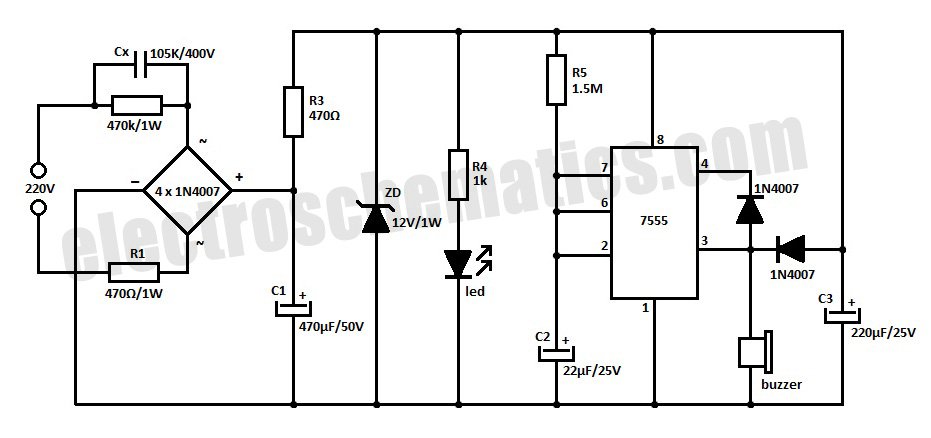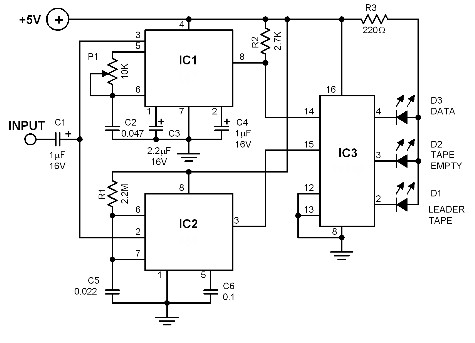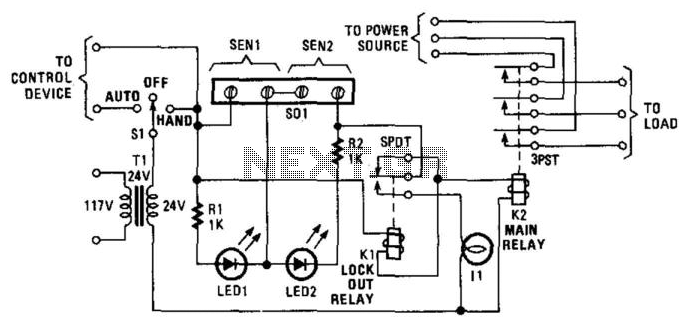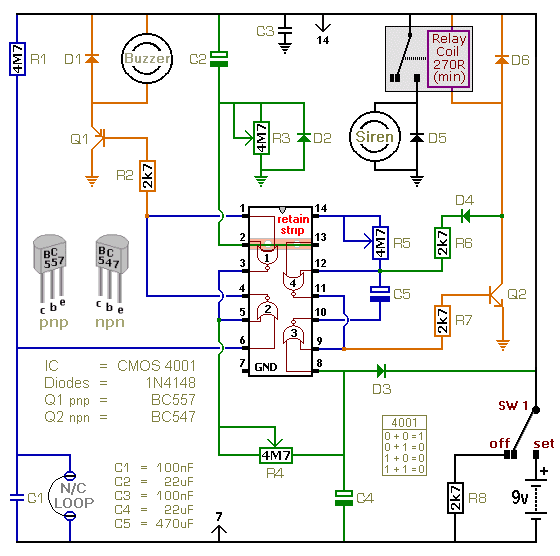
AC Power Monitor
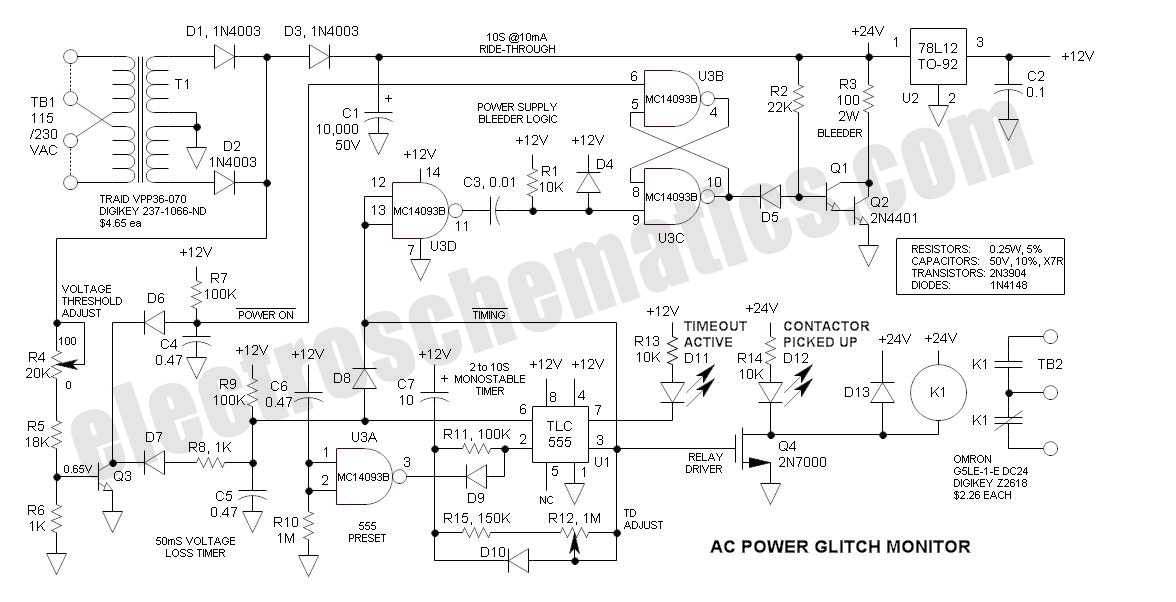
This AC Power Monitor continuously monitors the AC power line voltage for both under-voltage conditions and missing cycles. When it detects a total of 5 or 6 consecutive missing half-cycles (50ms, 50/60Hz), it activates a relay and initiates a timer. A power contactor is controlled by the relay contacts to protect power-loss sensitive industrial equipment from brief power interruptions by preventing immediate restart. After a specified time delay (2 to 10 seconds), the equipment may automatically restart. Although this task may seem straightforward, it is important to note that the condition being monitored is the absence of a periodic signal, and the timer may or may not have external power available. This function could also be performed by a programmable logic controller (PLC) with an uninterruptible power source (UPS), but such a solution would be more expensive and require additional panel space. A critical aspect of this circuit is its power-loss ride-through capability, allowing it to continue timing even after power interruption. Energy is stored in a large filter capacitor (10,000µF) to ensure that if power resumes during the timeout period, the timer remains operational, preventing sensitive equipment from restarting prematurely. At the end of the timeout period, a bleeder circuit activates to discharge the remaining charge. A 4000 series CMOS latch, consisting of U3B and U3C, is set by the positive transition of U1-3. If power resumes while the capacitor is discharging, the latch is reset via the signal at the collector of Q3, turning off the bleeder driver (Darlington pairs Q1 and Q2). Once all charge is dissipated by the bleeder resistor (R3), the circuit is ready to restart and monitor for voltage glitches again. The MC14093 is suitable for the power monitor application due to its Schmitt trigger inputs, which effectively handle slow input signal transitions, and it can be powered by a 12V Vcc. It shares the same pin configuration as the more common CD4011, which may also function adequately in the circuit. The timer utilizes the TLC555, a variant of the classic 555 timer known for its low quiescent current. It is configured as a monostable multivibrator triggered by a positive voltage at U1-6. To ensure the internal latch of the 555 is set correctly during power-up, capacitor C7 works against Vcc, while U1-2 is held low for 0.5 seconds through U3A, C6, and R10. The timeout period can be significantly extended by increasing the size of the timing capacitor C7, with C1 also requiring adjustment to provide additional ride-through capability, potentially extending to 60 seconds. It is important to note that the cathodes of diodes D1 and D2 are unfiltered, which is necessary for rapid power loss detection; a filter capacitor would otherwise hold up the voltage, interfering with the voltage loss timer. The filter capacitor (C1) is isolated via D3. The base-emitter voltage (Vbe) of Q3 (0.65V) serves as the voltage threshold comparator, which is influenced by the ratio of resistors R4, R5, and R6 to R6. The voltage threshold comparator's role is to keep C5 discharged. At each line voltage zero-crossing, C5 charges slightly but requires a full 50ms to reach the threshold at U1-6. If the voltage remains below the threshold of Q3, C5 will charge significantly; if 5 or 6 half-cycles are lost in succession, the voltage across C5 will reach the 8V threshold of U1-6, triggering the timer. Proper adjustment of R4 is essential for accurate operation. To perform this adjustment, a Variac should be connected to the power terminals, and the voltage should be reduced to the desired AC threshold voltage (e.g., 170VAC). The value of R16 should then be increased until the LEDs indicate a change in state.
This AC Power Monitor circuit is designed to ensure reliable operation of sensitive industrial equipment during power interruptions, utilizing robust components and configurations to maintain functionality even in the absence of external power. The combination of a large filter capacitor, a CMOS latch, and a reliable timer ensures that the system can handle transient power losses effectively, providing a practical solution for industrial applications. The choice of components, such as the MC14093 and TLC555, further enhances the circuit's reliability and efficiency, making it suitable for environments where power stability is critical. Proper calibration and adjustment of the resistors and capacitors are essential for optimal performance, ensuring that the system accurately detects voltage anomalies and protects connected equipment from unintended restarts.This AC Power Monitor continuously watches the AC power line voltage for both under-voltage and missing cycles. When it detects a total of 5 or 6 consecutive missing half-cycles (50mS, 50/60HZ), it drops a relay and starts a timer.
A power contactor is slaved to the relay contacts. Its purpose is to protect power-loss sensitive industrial equipmen t from brief power glitches by preventing immediate restart. After the specified time delay (2 to 10S), the equipment may automatically restart. Although this may seem like a simple task, note that the condition sensed is the absence of a periodic signal and that the timer may or may not have external power available. electroschematics. com is not really into industrial controls, but this may be the beginning ”this is where I spent most of my life.
This function could also be performed by a PLC (programmable logic controller) with a UPS (unterruptable power source), but such would be expensive and consume additional panel space. Key to this functioning properly is its power-loss ride-through capability. Note that this circuit continues to time out even after the power is interrupted. To run the circuitry for the entire time period, energy is stored in a large filter capacitor (10, 000uf).
That way if the power resumes during the timeout period, the timer remains alive and functioning so that the sensitive equipment may not restart. At the end of the timeout period, the bleeder circuit kicks in to dump the remaining charge. A 4000 series CMOS latch consisting of U3B & U3C is set by the positive transition of U1-3. Should the power resume while the capacitor is bleeding down, the latch is reset via the signal at the collector of Q3 so that the bleeder driver Darlington (Q1 & Q2) turns off.
When all of the charge is dissipated by the bleeder resistor (R3), the circuit is free to immediately restart and again monitor voltage glitches. The MC14093 is a good choice for the power monitor application. It has Schmitt trigger inputs for handling slow input signal transitions, and may be powered by the 12V Vcc.
It is identical in pin-out to the more common CD4011. Note that the CD4011 should also function acceptably, but I did not try it in the circuit. The timer is the good old 555 (actually, it is the TLC555 due to its low quiescent current). It is configured as a monostable multivibrator that is triggered via a positive voltage at U1-6. To assure that the internal latch of the 555 is set in the proper state during power-up, C7 works against Vcc (rather than common) and U1-2 is held low for 0. 5 sec via U3A, C6 and R10. The timeout period may be increased substantially by increasing the size of the timing capacitor C7. Note that C1 must be adjusted likewise to provide additional ride-through. 60 seconds is not unreasonable. Note that the cathodes of D1 & D2 are unfiltered ”this is necessary for rapid sensing of power loss ”a filter capacitor would tend to hold up the voltage thus interfering with the voltage loss timer.
The filter capacitor (C1) is isolated via D3. The Vbe of Q3 (0. 65V) is the voltage threshold comparator. This voltage is multiplied by the ratio of (R4, R5 & R6) to R6. The function of the voltage threshold comparator is to keep C5 discharged. At each line voltage zero-crossing C5 charges slightly, but requires a full 50mS to reach the threshold of U1-6. Should the voltage remain below the threshold of Q3, C5 starts to charge significantly ”if 5 or 6 half-cycles are lost in succession, the voltage across C5 charges to the 8V threshold of U1-6 and triggers the timer.
Proper adjustment of R4 is required. To do so, connect a Variac to the power terminals and reduce the voltage to the desired AC threshold voltage (e. g. 170VAC). Then increase the value of R16 until the LEDs change state. 🔗 External reference
This AC Power Monitor circuit is designed to ensure reliable operation of sensitive industrial equipment during power interruptions, utilizing robust components and configurations to maintain functionality even in the absence of external power. The combination of a large filter capacitor, a CMOS latch, and a reliable timer ensures that the system can handle transient power losses effectively, providing a practical solution for industrial applications. The choice of components, such as the MC14093 and TLC555, further enhances the circuit's reliability and efficiency, making it suitable for environments where power stability is critical. Proper calibration and adjustment of the resistors and capacitors are essential for optimal performance, ensuring that the system accurately detects voltage anomalies and protects connected equipment from unintended restarts.This AC Power Monitor continuously watches the AC power line voltage for both under-voltage and missing cycles. When it detects a total of 5 or 6 consecutive missing half-cycles (50mS, 50/60HZ), it drops a relay and starts a timer.
A power contactor is slaved to the relay contacts. Its purpose is to protect power-loss sensitive industrial equipmen t from brief power glitches by preventing immediate restart. After the specified time delay (2 to 10S), the equipment may automatically restart. Although this may seem like a simple task, note that the condition sensed is the absence of a periodic signal and that the timer may or may not have external power available. electroschematics. com is not really into industrial controls, but this may be the beginning ”this is where I spent most of my life.
This function could also be performed by a PLC (programmable logic controller) with a UPS (unterruptable power source), but such would be expensive and consume additional panel space. Key to this functioning properly is its power-loss ride-through capability. Note that this circuit continues to time out even after the power is interrupted. To run the circuitry for the entire time period, energy is stored in a large filter capacitor (10, 000uf).
That way if the power resumes during the timeout period, the timer remains alive and functioning so that the sensitive equipment may not restart. At the end of the timeout period, the bleeder circuit kicks in to dump the remaining charge. A 4000 series CMOS latch consisting of U3B & U3C is set by the positive transition of U1-3. Should the power resume while the capacitor is bleeding down, the latch is reset via the signal at the collector of Q3 so that the bleeder driver Darlington (Q1 & Q2) turns off.
When all of the charge is dissipated by the bleeder resistor (R3), the circuit is free to immediately restart and again monitor voltage glitches. The MC14093 is a good choice for the power monitor application. It has Schmitt trigger inputs for handling slow input signal transitions, and may be powered by the 12V Vcc.
It is identical in pin-out to the more common CD4011. Note that the CD4011 should also function acceptably, but I did not try it in the circuit. The timer is the good old 555 (actually, it is the TLC555 due to its low quiescent current). It is configured as a monostable multivibrator that is triggered via a positive voltage at U1-6. To assure that the internal latch of the 555 is set in the proper state during power-up, C7 works against Vcc (rather than common) and U1-2 is held low for 0. 5 sec via U3A, C6 and R10. The timeout period may be increased substantially by increasing the size of the timing capacitor C7. Note that C1 must be adjusted likewise to provide additional ride-through. 60 seconds is not unreasonable. Note that the cathodes of D1 & D2 are unfiltered ”this is necessary for rapid sensing of power loss ”a filter capacitor would tend to hold up the voltage thus interfering with the voltage loss timer.
The filter capacitor (C1) is isolated via D3. The Vbe of Q3 (0. 65V) is the voltage threshold comparator. This voltage is multiplied by the ratio of (R4, R5 & R6) to R6. The function of the voltage threshold comparator is to keep C5 discharged. At each line voltage zero-crossing C5 charges slightly, but requires a full 50mS to reach the threshold of U1-6. Should the voltage remain below the threshold of Q3, C5 starts to charge significantly ”if 5 or 6 half-cycles are lost in succession, the voltage across C5 charges to the 8V threshold of U1-6 and triggers the timer.
Proper adjustment of R4 is required. To do so, connect a Variac to the power terminals and reduce the voltage to the desired AC threshold voltage (e. g. 170VAC). Then increase the value of R16 until the LEDs change state. 🔗 External reference
